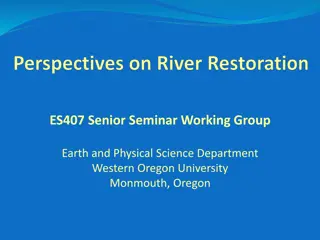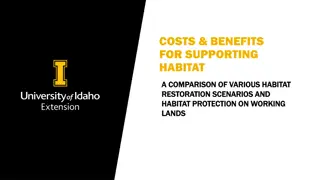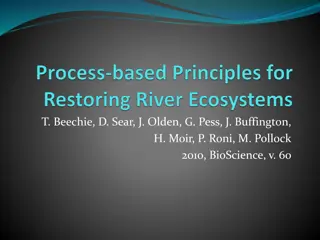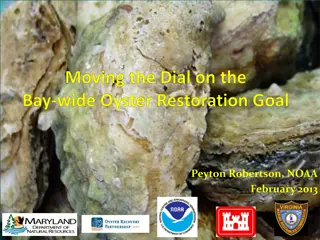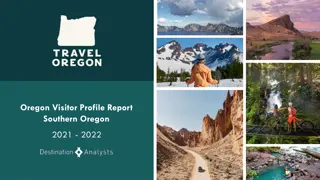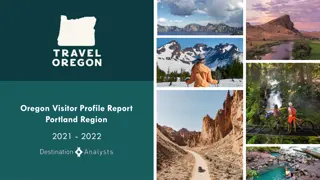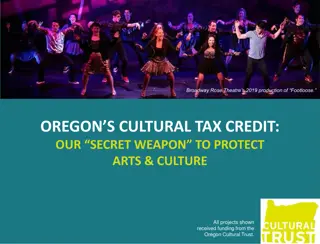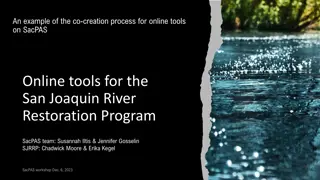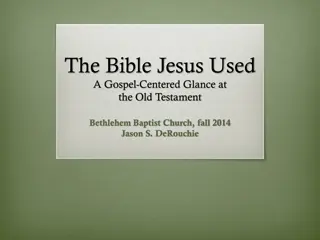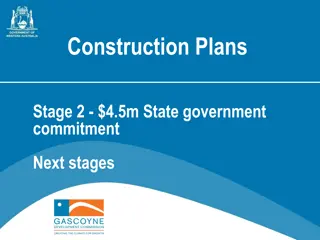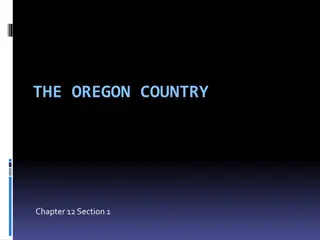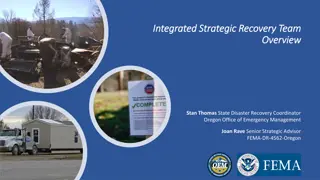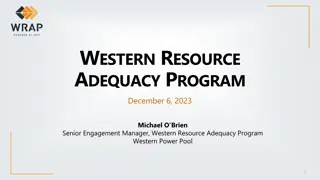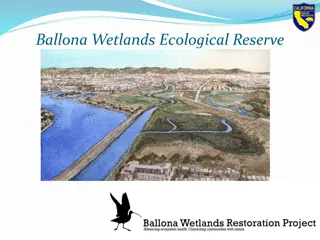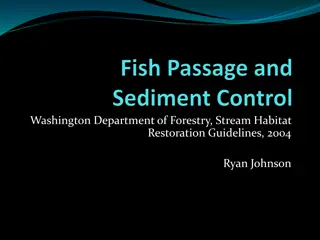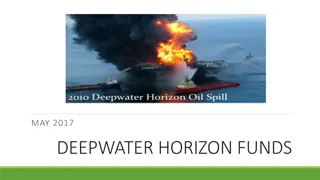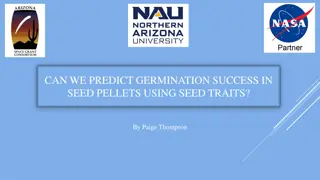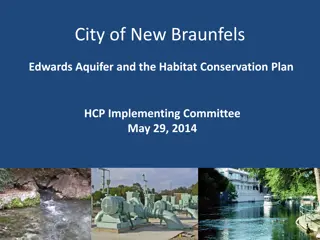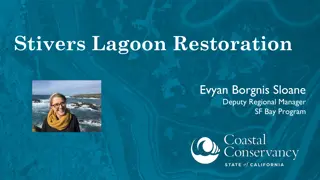Enhancing Restoration Efforts in Western Oregon
Exploring examples from Western Oregon where authorities are maximizing restoration efforts by utilizing environmental assessments, impact statements, and categorical exclusions. Smart practices, gaps filling, and the significant impacts of these efforts on timber harvesting and revenue generation in various regions are highlighted.
Download Presentation

Please find below an Image/Link to download the presentation.
The content on the website is provided AS IS for your information and personal use only. It may not be sold, licensed, or shared on other websites without obtaining consent from the author. Download presentation by click this link. If you encounter any issues during the download, it is possible that the publisher has removed the file from their server.
E N D
Presentation Transcript
Authorities to Maximize Restoration Some Western Oregon Examples
NEPA Environmental Assessment Environmental Impact Statement Categorical Exclusion http://amforest.org/wp- content/uploads/2016/05/Existing_Opportunities_to_Increase_Eff iciencies_in_the_Timber_Sale_Process.pdf
Smart Practices Maximizing implementation of acres analyzed though large-landscape EA s & EIS s Supplementing these landscape level documents with strategic use of Categorical Exclusions Filling in the gaps
Filling the gaps McKenzie River Ranger District Willamette National Forest Large landscape-level NEPA documents 2014 EIS considering 2,452 acres & 35 MMBF of timber harvest 2016 EIS considering 4,398 acres & 89 MMBF of timber harvest
Filling the gaps CatEx to treat up to 70-acre parcels 2014-2016 Categorical Exclusions Eleven individual Categorical Exclusions 497 acres treated 7.2 MMBF of timber harvested $1.2 Million generated If replicated across the other 14 Westside Districts 2,505 additional acres treated a year 36 MMBF of additional timber sold a year $6 Million additional generated a year
CE Sales for Fiscal Year (FY) 14-16 Total Value Acres Decision Name MBF TONS Bid Rate Remarks FY 2014 Timber Sales $249,381.3 0 Castle CE Units was combined with the Horse EA Units. No gaps Buck TS Units 1-3 & 11 51 acres Castle Project Decision Memo 851 4,782 52.15/Ton $213,248.5 6 Pup TS Units 1-3, 11-14 55 acres Pup Project Decision Memo 980 5516 38.66/Ton This includes 5 acres of gaps Fritz TS Units 1-4, 12, 13, 15-18, 20-23 $202,104.1 0 59 acres Fritz Project Decision Memo 1320 6886 29.35/Ton This includes 5 acres of gaps FY 2015 Timber Sales $133,781.0 4 Boundary TS Units 1, 2, 10-14 56 acres Boundary Thin Project Decision Memo 913 5,234 25.56/Ton This includes 7 acres of gaps Cub TS Units 1-3 66 acres Cub Thin Project Decision Memo 510 3,108 24.60/Ton $76,456.80 No gaps Pass TS Units 1-3, 11, 21, 22, 31, & 32 21 acres Pass Thin Project Decision Memo 260 1,489 23.35/Ton $34,768.15 This includes 5 acres of gaps MRRS TS Units 1 & 11 22 acres MRRS Thin Project Decision Memo 320 1,678 16.32/Ton $27,384.96 No gaps Muskee TS Units 1-3, & 31 46 acres Muskee Thin Project Decision Memo 560 3,211 18.71/Ton $60,077.81 This includes a one acre gap Lamb TS Units 1-3, 21, & 22 43 acres Lamb Thin Project Decision Memo 570 3,240 15.07/Ton $48,826.80 No gaps FY 2016 Timber Sales Air CE Unit was combined with three Goose/Honker Units. No gaps in Air CE. Air TS Unit 1 28 acres Air Thin Project Decision Memo 284 1339 41.65/Ton $55,769.35 D Special Salvage TS (SSTS) Unit 1 D Blowdown Removal Project Decision Memo 68 blowdown and root sprung trees was removed across 2 acres. 2 acres 41 62 CCF 157.00/CCF $9,734 $100,285.2 0 Ollie TS Unit 1-3 47 acres Ollie Thin Project Decision Memo 583 2504 40.05/Ton This includes 4 acres of gaps SR Danger Tree Removal (DTR) Project Decision Memo 18 Danger Trees along the 655 road was removed under this project. SR Salvage TS Unit 1 1 acre 45 61 CCF 178.00/CCF $10,858
Moral of the story Large landscape analyses may not, by themselves, capture all of the acres in need of treatment. Consider taking a page from McKenzie s model to fill the gaps. The results are minor but could be profound if implemented across the Region. McKenzie's model Dedicated program lead Integrated District support
Maximizing larger landscape projects Rogue River-Siskiyou National Forest Completed a large landscape EA called Coastal Healthy Forest Treatments in 2006 that encompassed two Ranger Districts. A Decision Notice was issued in 2007 authorizing the treatment of 47,329 acres identified in the 2006 EA. Monitoring conducted between 2007 & 2014 indicated that only 7,076 acres of these acres were actually implemented 15% Approximately 630 acres of additional stands, similar in forest type, in need of treatment identified in the project area. What to do?
Maximizing larger landscape project cont. Options: Initiate a new EA Treat a fraction of the 630 acres with the 70-acre Categorical Exclusion Supplement existing NEPA New information/changed circumstances Significant & substantial The Rogue went with option three. However
Maximizing larger landscape project cont. While completing a Supplemental Information Report (SIR*) they determined that a supplement was unnecessary. This report concluded that, as a result of the new information (in this case monitoring results), adding these 630 acres of new candidate stands was not significant because the conditions of these stands were the same as the 40,000 acres yet untreated stands under the existing decision. *SIR is the agency s internal tool used to determine supplementation
Maximizing larger landscape project cont. Result: The Rogue River-Siskiyou National Forest treated an additional 154 acres of stands in need of treatment. This sale offered 3.1 MMBF of timber to the local industry. $266,999 was generated from this sale and returned to the treasury. Paperwork required Three-page SIR to the file
Moral of the story Consider revisiting existing NEPA documents to monitor the level of implementation. If a deficit in treatment acres exists then consider opportunities to treat more of the project area.
Questions? Andy Geissler Western Oregon Field Forester American Forest Resource Council Eugene, OR ageissler@amforest.org 541-525-6113


